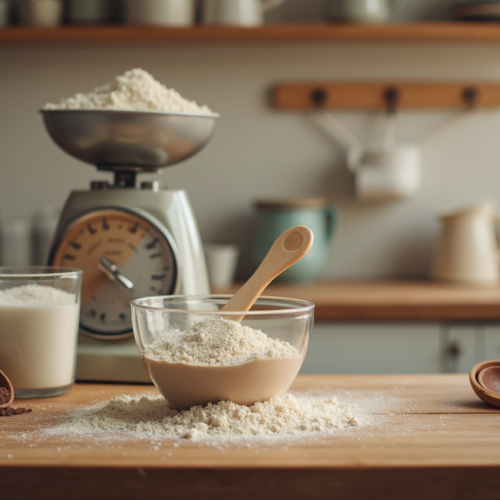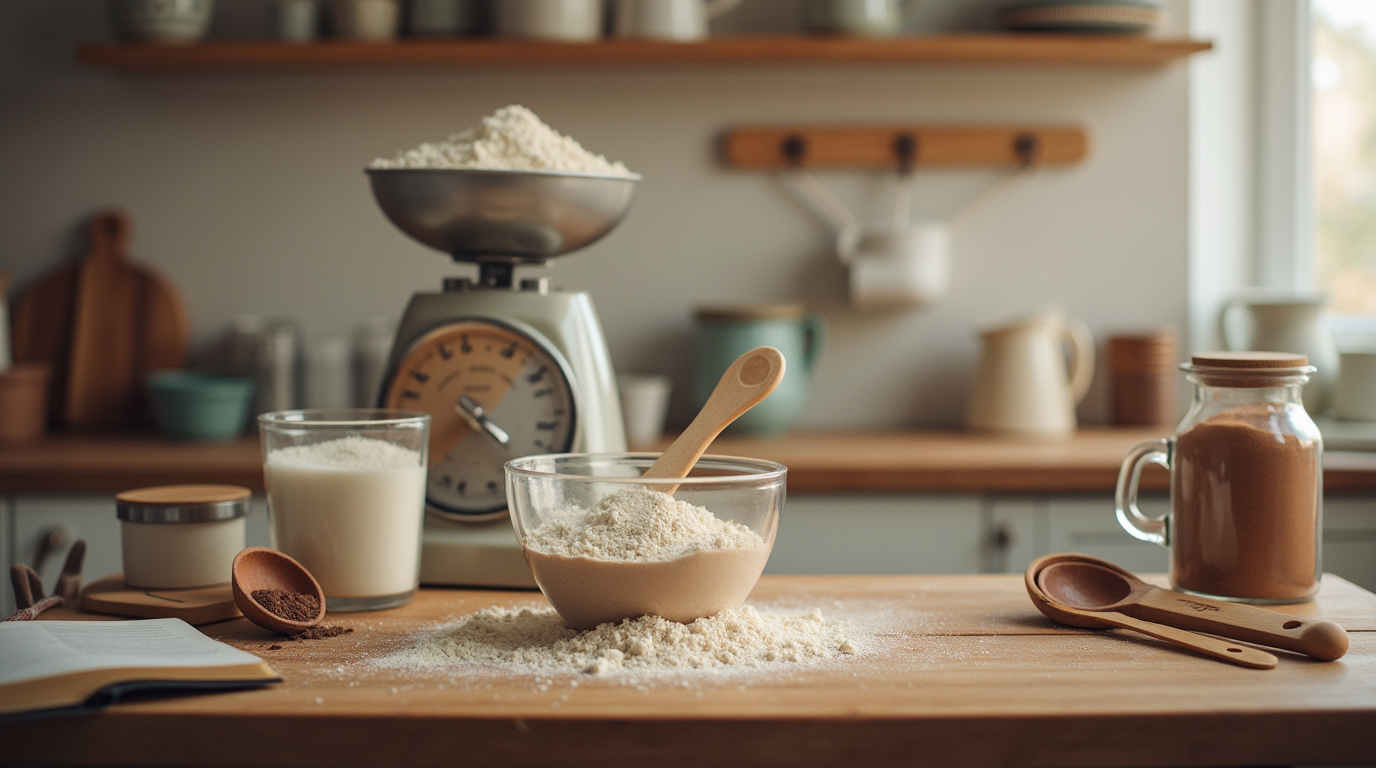How to Properly Measure Baking Ingredients
Baking is a craft, a delicate balance of precision and passion. Every time I share a recipe, my hope is to empower you to step into your kitchen with confidence and joy. Baking from scratch doesn’t have to be daunting. With the right tools, techniques, and a sprinkle of curiosity, you can transform your kitchen into a space of creativity and delicious triumphs.
Today, we’re delving into a seemingly simple yet fundamentally crucial step: measuring ingredients properly. It might feel trivial, but it’s the cornerstone of every successful bake. Unlike cooking, where a pinch of this or a splash of that can lead to delightful improvisation, baking is a science. Precision is everything. A single mismeasured tablespoon ingredient can turn gooey cookies into unyielding rocks or a fluffy cake into a dense brick.
Let’s uncover the secrets to mastering this essential skill, one ingredient at a time.
Table of Contents
The Art of Measuring Ingredients: Flour
Flour is the backbone of most baked goods, yet it’s also the most commonly sugarmis-measured ingredient. Whether you’re working with all-purpose flour, bread flour, or cake flour, the method remains the same:
- Spoon & Level: Avoid scooping flour directly from the bag or container with your measuring cup. This compresses the flour, often adding up to 50% more than intended. Instead, use a spoon to gently fill your measuring cup.
- Level Off: Once filled, use the back of a knife to level the flour. Resist the urge to tap the cup, as this packs the flour further.
Key Tip: Drill this into your mind: spoon and level. Do not scoop.
What About Sifted Flour? If a recipe calls for “1 cup sifted flour,” sift first, then measure. If it says “1 cup of flour, sifted,” measure first, then sift. The placement of the word “sifted” makes all the difference.
Measuring Ingredients: Sugar (Sweet Simplicity)
Sugar is more forgiving than flour but still demands respect. Here’s how to measure various types:
- Granulated Sugar: Scoop directly from the container, then level it off.
- Brown Sugar: Always pack it firmly into the measuring cup unless stated otherwise. Light and dark brown sugar are interchangeable unless specified.
- Confectioners’ Sugar: Use the same spoon & level method as flour. If the sugar is lumpy, sift it for smooth results—particularly important for icings and frostings.
The Mystery of Cocoa Powder
Cocoa powder’s fine texture makes it prone to clumping. Measure it using the spoon & level method, and sift if the recipe calls for it. Dutched or natural cocoa powder? Stick to what the recipe specifies; their acidity levels differ, which affects the chemistry of your bake.
Measuring Ingredients: Liquids (A Matter of Perspective)
Liquids like milk, oil, and water require a liquid measuring cup. Pour to the desired level, then crouch down to check at eye level. Precision is key here; even a slight miscalculation can alter your recipe.
For sticky liquids like honey or molasses, spray the measuring cup lightly with nonstick spray first. This makes pouring and cleanup effortless.

The Unsung Heroes: Semi-Liquids
Ingredients like sour cream, yogurt, and peanut butter fall into this category. These are best measured in dry measuring cups using the spoon & level method. Use a spatula to scrape every bit into your mixing bowl—every gram matters!
Add-Ins: The Fun Stuff
Chocolate chips, nuts, dried fruits, and sprinkles bring joy to your recipes. Measure these by simply scooping them into a dry measuring cup. Since they don’t affect the structure, precision is less critical here.
The Precision of Weighing
A cup isn’t always a cup, but a gram is always a gram. For ultimate accuracy, invest in a kitchen scale. This tool eliminates the guesswork, especially when working with varying ingredient densities.
For example:
- 1 cup of all-purpose flour = 125 grams
- 1 cup of granulated sugar = 200 grams
When developing recipes, I rely on weight measurements for consistent results. Once you embrace this habit, you’ll wonder how you ever baked without it.

Tools of the Trade
- Flour Keepers: Airtight containers are a game-changer for bulk storage. Label them for easy identification.
- Measuring cupsSpoons and Cups: Invest in a good set for both dry and liquid ingredients.
- Food Scale: Precision at your fingertips.
Confidence Through Mastery
Every time you measure with care, you set yourself up for success. By understanding the nuances of each ingredient, you’re not just following a recipe; you’re creating art.
Baking may begin as a science, but it transforms into magic when you approach it with love and precision. So, let’s put the fun back into your kitchen and make every bake a masterpiece.
Happy baking!

How to Properly Measure Baking Ingredients
Ingredients
Baking Conversions
FLOURS
- 1 cup all-purpose flour = 125 grams 4 1/2 ounces
- 1 cup sifted all-purpose flour = 115 grams 4 ounces
- 1 cup bread flour = 130 grams 4 1/2 ounces
- 1 cup sifted bread flour = 121 grams 4 1/4 ounces
- 1 cup cake flour = 115 grams 4 ounces
- 1 cup sifted cake flour = 100 grams 3 1/2 ounces
SUGARS
- 1 cup granulated sugar = 200 grams 7 1/2 ounces
- 1 cup packed brown sugar = 200 grams (7 1/2 ounces)
- 1 cup confectioners’ sugar = 120 grams 4 1/4 ounces
- 1 cup sifted confectioners’ sugar = 115 grams 4 ounces
LIQUID SWEETENERS
- 1 tablespoon honey = 21 grams 3/4 ounce
- ½ cup maple syrup = 156 grams 5 1/2 ounces
- ¼ cup molasses = 85 grams 3 ounces
SEMI-LIQUIDS
- ½ cup peanut butter = 135 grams 4 3/4 ounces
- 1 cup sour cream or yogurt = 227 grams 8 ounces
OTHER
- 1 cup milk = 227 grams 240 ml; 8 ounces
- ½ cup butter = 1 stick = 115 grams 4 ounces
- ¼ cup cornstarch = 28 grams 1 ounce
- 1 cup chocolate chips = 180 grams 6 1/4 ounces
- ½ cup natural unsweetened cocoa powder = 41 grams 1.6 ounces
- 1 cup oats = 85 grams 3 ounces
FAQ: Measuring Ingredients in Baking
1. Why is measuring ingredients accurately so important?
Baking is a science, and the balance of ingredients directly impacts texture, flavor, and structure. A slight miscalculation can lead to disappointing results.
2. Can I use the same measuring cups for dry and liquid ingredients?
While you can, it’s best to use dry measuring cups for dry ingredients and liquid measuring cups for liquids. This ensures better accuracy.
3. Do I really need to sift my ingredients?
If the recipe calls for sifting, it’s essential. Sifting helps break up clumps, incorporates air, and ensures even distribution of ingredients.
4. What should I do if I don’t have a kitchen scale?
You can follow the spoon & level method for dry ingredients and measure liquids at eye level. However, investing in a scale is highly recommended for precision.
5. How do I store my baking ingredients to keep them fresh?
Use airtight containers for flour, sugar, and other dry goods. Keep them in a cool, dry place away from sunlight and moisture.
6. Can I substitute brown sugar for granulated sugar?
In some recipes, yes, but it will alter the flavor and texture slightly due to the molasses content in brown sugar.
7. What’s the difference between natural and Dutch-processed cocoa powder?
Natural cocoa is acidic, while Dutch-processed cocoa is treated to neutralize its acidity. Always use what the recipe specifies to maintain the intended chemistry.
8. How often should I replace baking powder and baking soda?
Replace them every 6 months. To test their potency, mix baking powder with hot water or baking soda with vinegar, they should bubble vigorously if still active.


One Comment
Comments are closed.